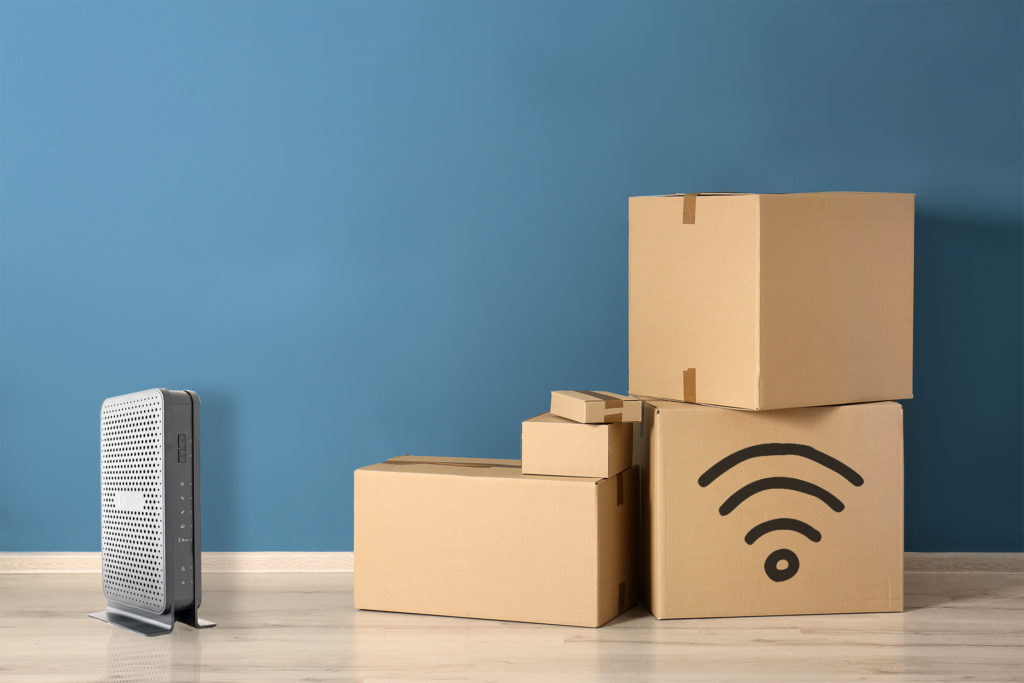
Getting Ready to Move? Here’s How To Get the Best Internet in Your New Home
Let’s face it: Moving is complicated. Through all the packing and unpacking, the last thing you want to worry about is setting up your Wi-Fi. Fortunately, staying digitally connected is relatively straightforward. By knowing these steps ahead of time, you can avoid gaps in coverage and stay online during each phase of your move. Here’s what you need to do (and when you need to do it).
1. Find out what your internet options are.
Before selecting an internet service provider (ISP), you’ll want to review all your options, including the reach of your current provider’s network. In many cases—especially if you’re in a smaller-sized city and planning to stay—your current ISP can move right along with you. But in many larger cities, ISPs might only cover a portion of the metro area, in which case you’ll need to switch. If you’re moving to the opposite coast, a switch is also more likely. Quick search tools like All Connect or Broadband now can show you your ISP options at your new address.
2. Pick your provider.
Has your current internet been slow? Are you switching to a new job that might demand more digital bandwidth?Are you wanting to stay flexible and avoid a long-term contract? A move is a perfect time to consider these questions to make sure you have the best internet service to meet your changing needs. Five aspects you’ll want to consider are:
- Speed: Your internet speed needs (measured in Mbps, or megabits of data per second) can range from 1 Mbps for sending emails to 25 Mbps or more for video streaming and gaming. If you’re sharing your bandwidth with multiple users in your house, fiber internet will be a faster, more reliable option. To determine how much bandwidth you need, this Mbps chart can help.
- Data cap: Data caps are the limit each month on how much data you can use. Similar to speed, you’ll want to make sure this is sufficient for your needs. An indication that you might need a higher cap is if your internet starts to slow and stays that way. You may also be able to find a plan without data caps, so discuss this with your provider.
- Contract terms: Many contracts of popular ISPs are two years and can carry cancellation fees, so make sure you read and understand the terms of your contract.
- Bundling: If you have only internet service now and want to add a phone line or a TV package, look into bundling options. You could save more having both services come from the same provider.
- Fees: From installation to cancellation, make sure you know what you’ll be paying beyond the monthly bill. This guide of common ISPs can give you a general idea of what to expect.
Some companies, in their pledge to keep people connected during COVID, are also waiving certain fees and offering discounted plans for low-income families. For these reasons, it’s best to call the provider for the most up-to-date information on rates and discounts.
3. Call your current provider.
If your current ISP also services your new address and you’re considering sticking with them, this is a good time to give them a call to ask about bundling and any deals. You can say something like: “Hi there, I’m calling to discuss my internet options. I’m considering switching a different provider and wanted to ask a few questions.” Since your ISP wants to make sure you’re a happy customer, they’re likely happy to talk through your options and any deals they can offer you.
If you decide you do want to stick with your ISP, on this same call you can let them know your new address and planned move-in date. If instead you decide you’d rather switch providers, you shouldn’t cancel your current service right away. Getting set up with your new ISP can be as quick as 48 hours or take as long as 2-3 weeks, depending on your installation needs. Best to wait until your new internet is up and running so as to avoid any gaps in your service. For this reason, we recommend calling and scheduling your new ISP at least two weeks out to have some lead time.
4. Pack up your modem and router.
Since different ISPs use different equipment, your current modem and router won’t work for all providers. Whether you’re switching or sticking with your current ISP, you’ll need to pack up your modem and router. If you’re changing to a new provider, you’ll need to return your modem and router back to your current ISP. You can either drop them off in person or send them back by mail.
If you’re keeping the same ISP, simply pack up your hardware to move it carefully to your new place. For billing and information purposes, you’ll want to let your ISP know your new address and your planned move-in date asap.
5. Schedule your new internet setup.
If you’re making the switch, we recommend calling your new ISP at least two weeks before your move and setting up an installation date for as close to your move-in as possible (if not the same day). Be sure to pick a date when you can be there in person and add buffer time around the appointment in case it takes longer. Your ISP technician will bring the modem and router you need. Once they’ve gotten you successfully online, it can be a good idea to perform your own internet speed test before they leave to make sure your connection is up to snuff. If later on you notice hiccups in your signal, you can also try these tips to improve your WiFi connection.
6. Cancel your old internet service.
Of course you don’t want to be paying for two services, so if your new ISP is set up, time to cancel the old. Remember not to cancel until your new signal is working. This will help on moving day as well, giving you internet access as you’re in the process of moving out.
With a little planning and a few phone calls, switching or transferring your ISP should be relatively easy. By considering your digital needs, budget, and schedule well ahead of time, you can find the best internet service for your new home and avoid WiFi gaps when moving time comes.




Join the conversation